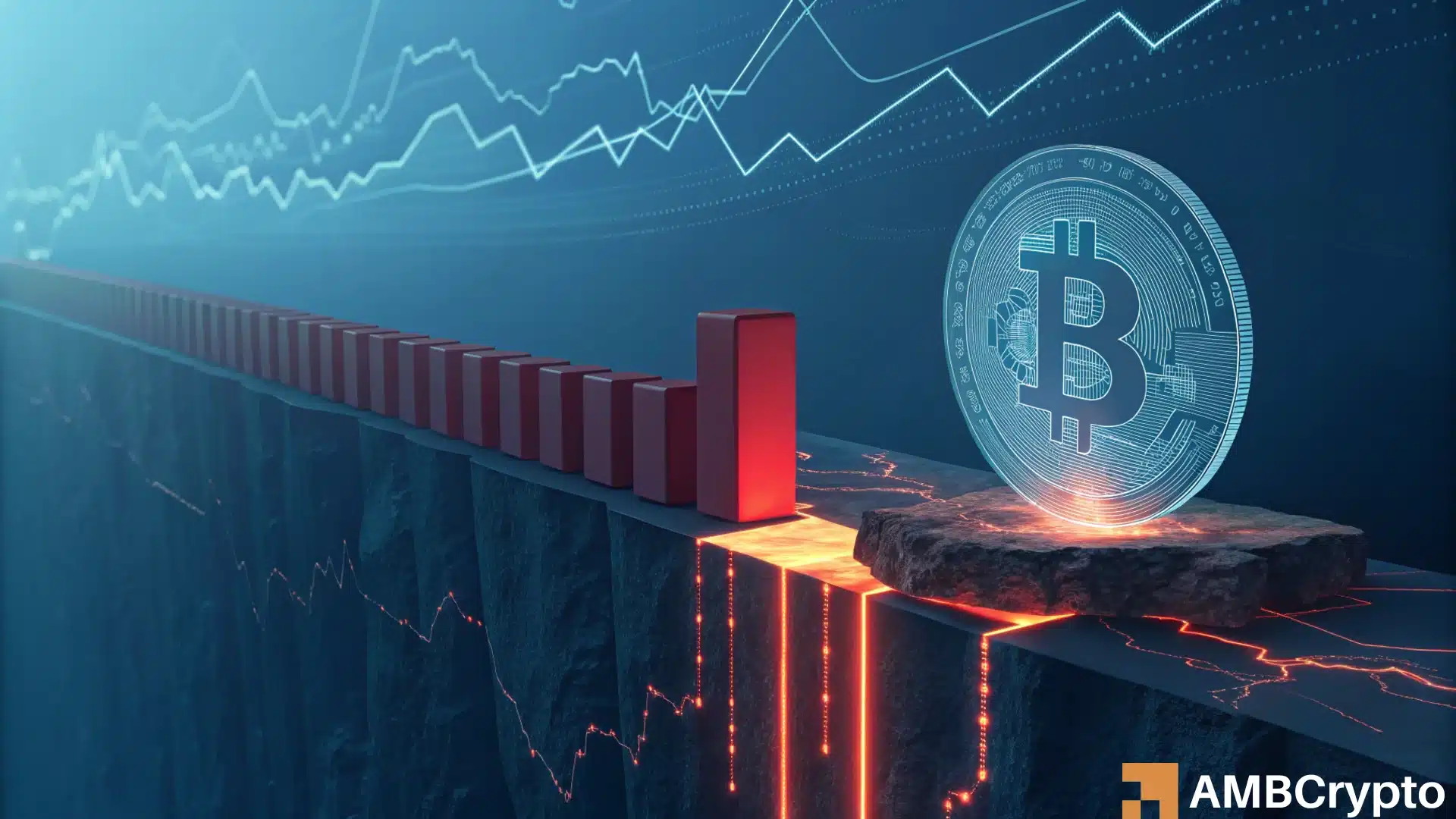Bitcoin whales are buying while weak hands panic – Is a market bottom near?
Whale alert: Over $1B in USDT minted as Bitcoin investors gear up to buy the dip
Crypto traders in ‘wait-and-see’ mode ahead of ‘Liberation Day’ tariffs
Image with chinese name
Description

Second image

Third image

Fourth image

Fifth image

Sixth image

Bitcoin: Why BTC holders cut spending by $10B – Impact on prices?
BTC has fairly recovered over the past evening, rising by 1.37 %. Currency’s 3-6 million long-term recipients have seen their riches quickly rise. Over the past two months, Bitcoin]BTC ] has experienced extreme volatility. Despite increased swings, Bitcoin’s long-term recipients remain resolute in the market. As for, long-term buyers have seen their riches rise despite the prevailing market conditions. According to Glassnode, 3-6 million Cryptocurrency buyers, especially those transitioning into long-term owner reputation, have seen a sharp increase in the success they held. Origin: Glassnode AMBCrypto has identified increasing prosperity among long-term buyers, with the LTH MVRV amount maintaining good momentum since December 2024. This indicates that BTC’s significance for long-term recipients remains relatively large compared to its price base. Previously, good LTH MVRV speed reflects renewed assurance among these holders. Although many of these currencies were acquired near all-time higher levels, their continued aged demonstrates judgment more than indicators of surrender. Origin: Checkonchain As long-term buyers see their income grow, they remain steadfast in holding their BTC. Spending action from 3–6 million Bitcoins recipients has dropped to its lowest level since mid-2021. This reduced action supports the notion that new best buyers are maintaining their positions instead of selling, also amid ongoing market uncertainty. Origin: Glassnode So, Bitcoin’s LTH spent provide has seen a sustained reduction since February 2025. As such, the amount spent has declined from a high of$ 18 billion to$ 8 billion as of the 31st of March 2025. This suggests that buyers are spending less and less BTC, reflecting a rising concentration tendency among LTH. With increased having, it suggests that investors are enthusiastic about the long-term possibility of BTC and assume more profits. Origin: Checkonchain Looking further, across the 2023-2025 pattern, long-term buyers have distributed over 2 million BTC. This transmission has been followed by a powerful re-accumulation, helping process the sell side stress. This continuous compromise has played a vital role in stabilizing Currency’s price activity. What it means for BTC With long-term holders maintaining their optimism, Bitcoin is unlikely to face significant sell pressure, as this group continues to hold rather than sell. A reduced spending rate among long-term holders enables BTC to absorb selling pressure from short-term and speculative investors. This balance between selling and accumulation suggests that Bitcoin will likely trade within a consolidation range. Short-term and speculative investors are entering the market to capitalize on rebounds and take profits. The bullish sentiment among long-term holders positions Bitcoin for potential price gains. If their conviction persists, BTC is expected to hold firmly above$ 81k, paving the way for a possible rebound toward$ 87, 500. As long as long-term holders continue to hold, there is room for growth. However, if their conviction falters, Bitcoin may experience a sharp decline, dropping below$ 80k again. Previous: Cardano could unlock Bitcoin’s DeFi potential – Charles Hoskinson Next: Could Trump pocket 75 % of WLFI’s revenue? – A$ 400M question
Bitcoin eyes $83.1K breakout – Will compressed shorts trigger a squeeze?
Bitcoin has been hovering just below dense short liquidation clusters between$ 83, 100 and$ 83, 500 Open interest dropped by 9 % in one week, highlighting trader exit or liquidation pressure Bitcoin]BTC ] is nearing a critical threshold, with its price now close to tightly packed short liquidation levels. In fact, on 30 March, TheKingfisher placed Bitcoins at$ 82, 621.9, with the crypto positioned between two opposing bankruptcy areas on the tables. Source: X At the time of writing, the short positions cluster was between$ 83, 100 and$ 83, 500, while the long liquidations stretched below$ 82, 400. This encoding sets the stage for more uncertainty on the tables. A press waiting to happen? Zooming into the table structure, the disparity seemed to be evident. The short liquidation band sat just 0.6–1.1 % above spot. However, long exposure seemed to be more frequently dispersed. This creates an irregular force area supporting cows if the lower limit is breached. Then, consider how this unfolds across trading systems. Binance and Bybit highlighted the most focused short positions, based on color-coded regions in the heatmap. This suggested platform-specific threat. If value begins to walk, these clusters may cause stop-outs first – Pushing Bitcoin into a pressured buying cycle. Help for this installation comes from everyday heatmap exercise too. Source: CoinGlass Coinglass data also showed that Bitcoin rose from$ 80, 673 to$ 83, 618 on 31 March. Bankruptcy utilize surged to$ 35.43M during this walk. The schedule wasn’t strange while, as most engagement occurred between 15: 15 and 18: 30. A boom … or just the begin? Layer in Bybit’s figures, and the message strengthens. In reality, a distinct heatmap recorded the event’s top at$ 83, 642. Liquidation leverage hit$ 48.98M, with over 70 % of total liquidations packed between$ 81, 000 and$ 83, 600. Origin: CoinGlass This seemed to confirm that utilized little positions were stacked near its push time levels. What sits behind this liquidity though? Also, Exchange Netflows might provide a clue. According to CryptoQuant, for example, Bitcoin withdrawals have dominated Binance and Bybit since February. Origin: CryptoQuant Investors have been pulling resources amid the cryptocurrency’s falling costs. Source: CryptoQuant Yet after inflows of 4, 258 BTC on 28 March, the industry has remained under stress – A indication that these were possible short-term placing inflows, no long-term accumulation. Look back to see ahead Zoom out more, and the amount pattern highlighted this attitude. Since peaking at$ 106, 164 on 21 January, Bitcoin has dropped by 22 %, closing March at$ 82, 500. This drop seemed to be in line with continual flows and increasing liquidation events. Finally, there’s the money rate. Origin: CryptoQuant Between 24-28 March, charges were negative—indicating short-dominant attitude. But, by 30 March, that flipped. Good funding rates then mean rising much exposure. It’s a critical attitude change. Clothes may be closing, and yearns perhaps be beginning to re-enter. Pair this with Open Curiosity and the image enhances. The quiet before the walk? Open interest fell from$ 25.39 billion to$ 23.12 billion over the last week of March. The sharpest drop came on 28 March. That fall indicated big position closures or foreclosures. As Open Interest falls and money rises, it usually marks the beginning stages of business shifting. Origin: Coinalyze Shorts outweighed strives by 1.5–2x, triggering a layout previously linked to 60–65 % higher uncertainty, as per TheKingfisher. Recent bankruptcy regions meet that threshold, with a key opposition at$ 83, 100. A break above$ 83, 100 may push Bitcoin towards$ 83, 500, with low resistance extending to$ 83, 877. Heatmap data revealed little buy tension in this collection, resembling before little squeezes. If Bitcoin fails to clear opposition, negative attitude may profit. Particularly if money flips bad or inflows drop. However, with stored shorts, positive financing, and aligned heatmaps, the short-term partiality may be leaning optimistic. Furthermore, market timing remains crucial. And, the screen for inside is narrowing. Earlier: TRON vs. Cardano: Will TRX overtake ADA’s$ 23B business cover? Next: BERA’s cash flows defies price fall —Is a protest still possible?
Quarter of S&P 500 firms to hold Bitcoin by 2030 – Treasury Execs’ warning!
Bitcoin as a treasury asset is still evolving, forcing companies to choose between risk management and blindly chasing MSTR’s success Today, 90 publicly traded companies hold BTC on their balance sheets Bitcoin]BTC ] as a treasury reserve asset is still a bold, unproven move, but more companies are jumping on board. The thought? BTC trees against prices and adds diversification to business balance sheets. MicroStrategy kicked off this tendency in 2020, seeing huge profits, but newer users like GameStop are joining the record. With 90 businesses now holding BTC, the big question is – Will this be the rule? Some experts predict that by 2030, a third of the S&, P 500 may include Wallet coverage. Business under pressure – Is Bitcoin the new enjoy? 2025 is all about mega changes shaping the markets, and companies are feeling the pressure. The S&, P 500 closed Q1 down$ 2 trillion in market value, inflation ticked up to 2.8 %, and a 25 % auto industry tariff is shaking things up. Also Tesla couldn’t escape the heat, with a weaker-than-expected Q1 efficiency. With all this confusion, it’s no wonder Bitcoin’s growing position in corporate stability sheets is making headlines. However, there’s another big reason for the buzz – MicroStrategy ( MSTR ) bet on BTC as its primary treasury asset back in 2020, and the results have been massive. Since then, while the S&, P 500 has gained by 64.81 % and BTC has surged 781.13 %, MSTR’s valuation has skyrocketed by 2, 074.85 %. With over 500, 000 BTC in its treasury, S&, P 500 companies are now wondering – You they take off the same enjoy? Origin: BitBo MSTR’s property says it all. In Q4 2024, Bitcoin crossed$ 100k, sending MSTR past$ 500 for the first time. But today? It’s down 45 % to$ 277. With Bitcoin swinging on micro uncertainty and golden hitting record highs, the major question remains – Does adding BTC to the S&, P 500 stability plate make for a bright government move or simply a high-risk bargain? BTC on business balance sheets – A smart walk or a dangerous guess? Recently, GameStop ( GME) announced a$ 1.3 billion plan to adopt BTC as a treasury reserve asset. However, the business wasn’t convinced – GME share dropped 20 % after the information. Why? As AMBCrypto pointed out, BTC’s long-term potential is huge, but its short-term uncertainty is a big risk. And when Bitcoin falls, businesses holding it get an even bigger reach. In truth, skeptics ask – If companies don’t carry gold as a treasury asset, why do they keep BTC? Especially when golden remains the go-to healthy haven in stormy areas. And the logic checks out – Gold just hit$ 3, 100 while Bitcoin slipped to$ 77k. The statistics speak for themselves. Source: TradingView (XAU/USD ) Still, with 90 S&, P 500 companies already holding BTC, some see this as just the beginning. Tech managers predict that by 2030, 25 % of S&, P 500 companies may have BTC on their balance sheets. But with Bitcoin’s exotic jumps, it’s a high-stakes walk – One that could either pay off huge or turn into a career danger. Previous: Ethereum – Here’s why$ 1.6K could be the altcoin’s next price target Next: Can Shiba Inu break$ 0.000015 again after dropping 12 % in a month?
Bitcoin: As stablecoins surge, assessing what it means for BTC
The stablecoin amount network indicates a possible purchase opportunity for Bitcoin and currencies. Rising bitcoin market cover suggests liquidity accumulation, hinting at probable bullish momentum forward. The stablecoin amount route is signaling a potential business change, hinting at a buying opportunity for Bitcoin]BTC ] and currencies. An increase in bitcoin business caps often marks an accumulation stage, as investors move funds from danger assets to stablecoins, waiting for efficient entry points. Previously, when this amount reaches critical rates, it has preceded substantial price motions, suggesting that the business may be preparing for a new pattern. An upsurge on the horizon? Origin: Alphractal The stablecoins market cover graph reveals a seasonal pattern where stablecoin supply tends to develop during negative phases and contract when the market turns optimistic. Now, the boom in cryptocurrency market cover suggests increased liquidity, indicating that investors may become accumulating secure assets while waiting for an ideal re-entry into Bitcoin and altcoins. Historically, such expansions have often preceded notable price rallies. Source: Alphractal Meanwhile, the stablecoin ratio channel chart shows the indicator reaching a historically significant accumulation zone. Previous cycles suggest that when the ratio hits this level, it often signals a bullish shift in Bitcoin’s price movement. The recent drop near the oversold region indicates that the market could be entering an accumulation phase, hinting at potential upward momentum ahead. Next: Dogecoin holds onto a crucial support: Is DOGE’s breakout brewing?
Bitcoin Fear and Greed Index urges caution – What should investors do next?
The Bitcoin Rainbow Chart showed that buyers may scoop up more BTC on the cheap. A deeper look at the attitude showed that buyers might want to wait. Bitcoin]BTC ] has shed 6.5 % since the 28th of March. Short-term BTC buyers were selling at a loss, and the annualized Sharpe amount showed that BTC risk-adjusted results were decreasing. Combined with the announcement of the U. S. taxes starting on the 2nd of April, attitude across the blockchain markets was muted. Origin: Blockchain Center The Bitcoin Rainbow Chart map showed Bitcoin was” also low”. This, by itself, if never guide long-term owners ‘ plans, for the leading bitcoin was still in a downturn. Possibly the second quarter of 2025 might be kind to the cows. Data showed that the coming months probably won’t be. BTC: Worry dominates the markets when suddenly Source: Alternative. me The Fear and Greed Index was in fearful place from late February. It did not cross above the 50 level in March but was making a series of higher lows. While technical research on the fear index might not be as revealing as it would be on the price charts, the latest dive below the 30 level suggested troubling times for investors, as it marked a fresh lower since mid-March. The dip in business sentiment came as the wider share market also braced for a strike. The wary sentiment would probably drive greater marketing pressure, driving costs lower. Origin: BTC/USDT on TradingView The 1-day BTC table indicates a clearly negative view in the short term. The 20DMA and 50DMA confirm the ongoing decline, as Bitcoin has yet to create a fresh higher great above$ 90k, maintaining its negative construction. Additionally, it has dropped below the$ 82.5k local support zone. Since February, the OBV has been trending upward. Although it stabilized in the latter third of March, reflecting a balance of power between buyers and sellers, this simply offered a slender chance of optimistic treatment. New marketing force has erased that promise, and the OBV is likely to reach a new lower in the coming weeks. If this happens, Bitcoin buyers should make for a potential value cut below$ 78k. While the Rainbow Chart recommends buying, recent market attitude and value trends suggest tolerance may produce better results. The decline endures, and until it reverses, optimistic buyers may need to wait for more beneficial conditions. Disclaimer: The information presented does not constitute economic, investment, trading, or other types of advice and is only the writer’s opinion Next: Elon Musk debunks rumors: U. S. government didn’t follow Dogecoin









